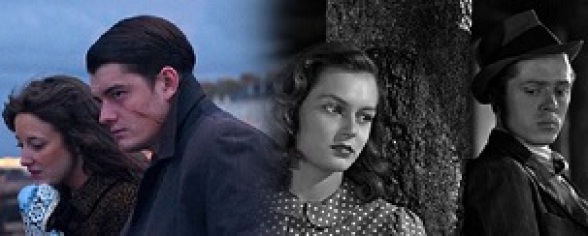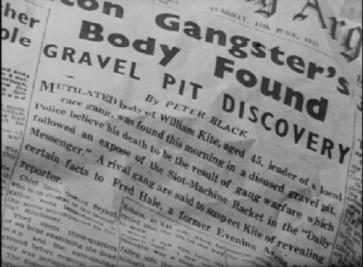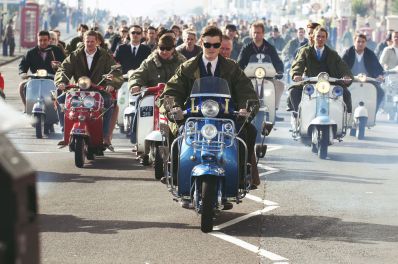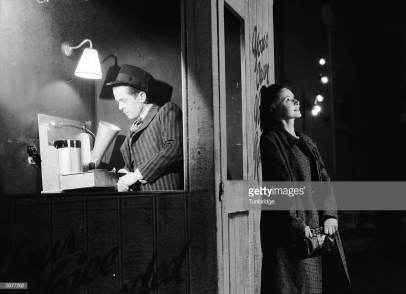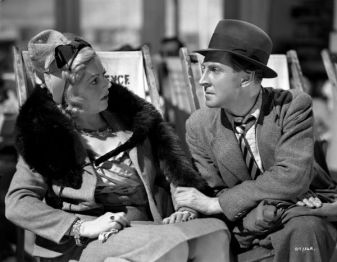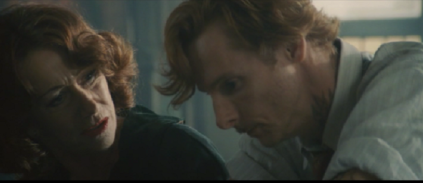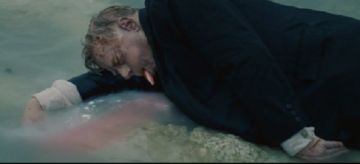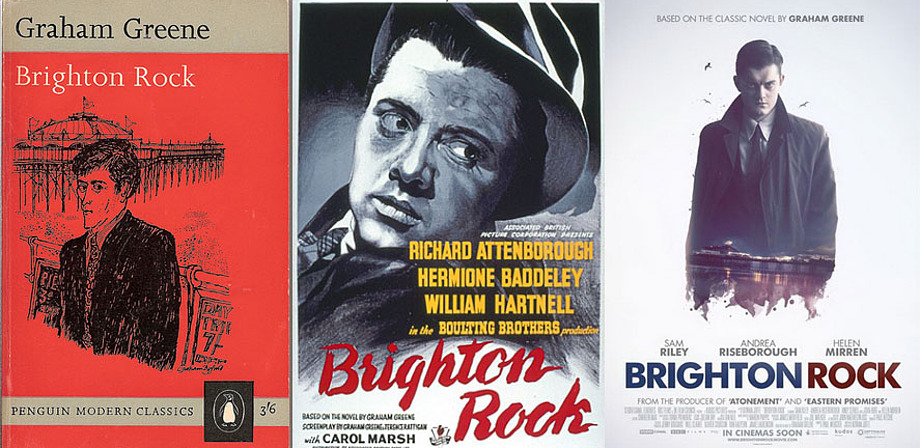
BRIGHTON ROCK (1947 and 2010)
From the novel by Graham Greene published in 1938
I have long wanted to write a page comparing Brighton Rock the novel with both the 1947 Attenborough version and the 2010 version with Sam Riley as Pinkie, but despite even doing all the research - reading the book yet again, watching both films version again - I never got round to it - until now, that is. Even so, to do a full blown 'contrast and compare' article would, I now realise, go beyond a website page (indeed, you could easily write a whole book on the subject). I've therefore settled for picking out a few characters, scenes, storylines and incidents from the three, just to make it manageable. I don't mention the religious element of the book and how the film deals - or ignores - said element, partly because this is not a scholarly article and in any case it has been discussed at length in numerous books and articles, and partly because, despite my wife and daughter being Catholics, I have little or no interest in religion of any description so that theme of the book has never bothered me.
Most of the research and thoughts come, as always, from my own viewings and readings, but in this instance I must just acknowledge a few people who have given me some ideas or confirmed what I was already thinking. In particular I have relied very heavily on Steve Chibnall's TCM film guide 'Brighton Rock', published in 2005, which looks at the 1947 adaptation, and a couple of articles I found on the web, one by Polly Allen from 2012 and the other by Sean Rom in 2011. I also had to hand notes from something on the internet I found called LitCharts (a sort of updated Brodie's Notes).
I refer to 'the 1947 version' and 'the 2010 version' for the films, but the book is just referred to as Brighton Rock. I assume a fairly thorough knowledge of at least the 1947 film version, if not the novel itself, so I'm not going to start saying things like 'Cubitt, who is a member of Pinkie's gang ' and suchlike. To be honest, if you don't know who Dallow, Rose and Ida are I'd stop reading now and go back and watch the film(s) and read the book.
Time setting, hanging and Dallow - some observations
The novel was published in 1938, and is set in June 1935 (see picture on the right); as the film opens after the credits, we see a sunbather with a newspaper on his head, with a headline about Kite being found dead. The date is Tuesday 11 June 1935 or 1936, but 11 June was a Tuesday in 1935 so there you go (thanks wikipedia!). The film goes out of its way - probably in order to get the local council on side - to make it clear that all the sordid events and characters are 'happily no more' (yeah, I bet) and that this was all pre-war.
It's always taking a risk when updating iconic books and films, but this is one time where I really think it works. The film is now set in 1964, and therefore deploys the device - although admittedly it plays little part in the narrative - of the mods and rockers and their seafront battles; Pinkie even gets to steal a moped at one point and this forms his mode of transport for the rest of the film, which again is a nice touch. The 2010 version sadly dispenses with the book's storyline of 'Kolly Kibber' leaving cards for the paper's readers, which plays such a key element in the novel's plot after Rose finds one that Spicer left to establish an alibi, and I did wonder if the film makers felt it would have been out of date in the 1960s? If so, they would have been wrong, as I vividly remember going on holiday in the late 60s/early 70s to Weston-super-Mare, and pestering my Dad incessantly as I wanted to spot one newspaper's (Daily Mail? Express?) equivalent of 'Kolly Kibber' on a certain day (needless to say I wasted the whole day to no avail). Another advantage of using the time setting, and in particular Mods and Rockers as a backdrop, is that it inevitably - as I suspect was the deliberate intention - evokes memories of Quadrophenia, also set, and filmed, in Brighton.
Just a quick word on hanging; the 2010 version in particular constantly refers to Pinkie - and occasionally Rose - being hanged, but to be honest this is a bit of a nonsense. I can't recall now if the 1947 film does likewise - if it does, when I watch it again, I'll update this page - but whether in 1935 or 1964 Pinkie would not be hanged, for the simple reason that, at 17, he is too young. A simple bit of research has shown that no one under the age of 18 was hanged in the 20th century, and anyway the Children and Young Persons Act 1933 raised the mimimum age to be executed to 18, so even by the time the book was published Pinkie would not have hanged. Hanging was about to be abolished completely anyway only a few months after the events shown in the 2010 film version.
And finally just a short note on Dallow. There has been no comment, as far as I can see, on Dallow being played by a black actor (Nonso Anozie) in the 2010 version; this is one of my bugbears to a certain extent in this current unhappy age, where only a day or so ago Will Smith was going to be cast as the father of Serena and Venus Williams only for there to be a row as he is not black enough. I'm not going to go into all this now, as it is too wide a topic and is not particularly relevant, but I mention it here as, on the one hand, it is irrelevant to the story, but on the other, I can't help feeling that it's all a bit unlikely, even in 1964. In the book Dallow is white, and in the 1947 version he is played by William Hartnell, who only the year before had been the lead in Appointment with Crime, another film in the spiv cycle of the time. Would gang leaders in Brighton in the 1960s have a black member? Maybe, but why change it? In any case, more to the point, the part seems to have been stripped away so that Anozie has very little to do; in one scene though Dallow comes across as very stupid, and is mocked by Cubitt, which is something of a role reversal. Anyway, onto some of the themes...
Pinkie
I saw the 1947 film version of Brighton Rock before I read the book, so for me – and most others, I suspect – Richard Attenborough is Pinkie, 17 year olds, a cold hearted, ruthless gangster and killer. Attenborough was 23 years old when he played the role, but he plays the role so perfectly that I never had a problem with his age, and he is utterly believable in the part. I didn’t realise for some years that he had played Pinkie on stage a few years before, at the Garrick in London in 1943, after 'dummy runs' in Blackpool and Bristol – the picture above shows him with Dulcie Gray as Rose – and had impressed Greene when he went to see the show. As an aside, Dulcie Gray got a film contract with Gainsborough on the back of her stage performances, but then ironically was too busy with her contract to take on the role when the Boulting Brothers were casting, thus giving Carol Marsh her chance. The film’s introduction of the character is vivid and memorable:
That scene introduces the gang, and makes it crystal clear, as Dallow says, that ‘Pinkie is the leader of this mob now’, despite his youth; and having seen his demeanour and chilling determination, it is evident why. In the 2010 version though, there are a few problems, despite a strong performance from Sam Riley. The first is that, at the age of 30, Riley was far too old for the role, and with the best will in the world he cannot pass for a 17 year old. The second, which is down to the script rather than Riley himself, is that for some reason Pinkie is depicted, initially at least, as a rather callow youth, out of his depth; the scene further down the page (not in the book), where he confronts Hale in the toilet but is outmanoeuvred and ends up cowering as Hale stands over him with a knife, gives a totally false impression of the character, and it is hard to understand why this scene was filmed.
Pinkie and Spicer
Spicer’s role in the 2010 version is interesting here, as it compares and contrasts with Pinkie’s role within the group. Look at the three scenes strung together here, showing how Pinkie and Spicer’s roles shift over time. In the first clip, just after Pinkie has killed Hale, Spicer appears to be in charge, and he refers to Pinkie as ‘boy’ and ‘kid’, whilst even Cubitt dominates him, calling him a ‘runner’ and implies that his main ‘talent’ is as a pickpocket. In the second clip, Pinkie shows more defiance but Spicer soon berates him, referring to himself as the leader of the gang; nevertheless Pinkie is growing in stature and has taken on some of the chilling quality of the Attenborough interpretation. In the third clip, just after Pinkie has been picked up for questioning by the police and Spicer thinks he has been arrested, the roles are now almost completely reversed and Spicer now resembles Wylie Watson’s character in the first version, too tired and old to carry on and just looking to get out with some dignity; meanwhile Pinkie is completely dominant, carrying a menacing threat.
Ida Arnold
The character of Ida is central to the book, where she is Pinkie’s nemesis, pursuing him – and the truth, as she puts it – doggedly, on behalf of Fred Hale. Greene doesn’t give her age, but repeatedly refers to her ‘big breasts’ and makes it clear that she is ‘brassy’; in that sense Hermione Baddeley is ideally cast, although it is very interesting to note that, despite her playing the role on stage, Greene himself was very 'anti' her being cast in the part, commenting on her stage performance that “her grotesqueness is all wrong for the part...she is meant to be a natural amateur bawd not an oddity whom nobody could possibly sleep with” (quoted in Chibnall p 62). At the time of filming Baddeley would have been 40, which may have been about right – I always got the impression from the novel that Ida was in her 40s – but in the 2010 version her role is taken by Helen Mirren, who certainly has the physical attributes, and sexual aura, detailed by Greene, but unfortunately at 65 (Mirren was born in 1945) is far too old for the part.
The biggest problem with the 2010 version however is that Ida’s role is – bizarrely – changed and twisted beyond all recognition from the original. In the book she is a barmaid in London – her ‘digs’ are near Russell Square tube – and she is down in Brighton for the races when she meets Fred Hale. She has never met him before, and does not know Pinkie, Rose or any of the other characters, other than Phil Corkery; this is why her crusade is a disinterested one, and can be successfully portrayed as a fight for justice, and right, as she explains throughout. Whilst the 1947 version changes her job from barmaid to touring actress, the rest stays true to the book. The 2010 version makes a big mistake in my view, by making Ida the manageress of Snow’s, the restaurant/tea shop in Brighton where Rose works; more importantly, as the following scene shows, she already knows Fred Hale and is on friendly terms with him (some of the articles I've read suggest that he is one of her ex-lovers, which may be the case, although certainly he clearly comes to her for financial assistance on a regular basis). This clip comes after Hale - whose character is completely altered from that in the novel, in this version he works for Colleoni rather than being a scared reporter, 'Kolly Kibber' - has killed Kite, Pinkie's mentor. This clip also includes the scene, added to the 2010 version and mentioned above, where Hale confronts Pinkie with a knife which he takes off him:
Spicer's death
In the book, we don’t read of Spicer's death, which takes place ‘off-book’. When Pinkie finds out that Spicer is still alive after Colleoni’s mob attacked him, he goes to see him in his room:
The Boy said nothing, watching from the door. As if he were apologizing for being alive at all Spicer explained, ‘I got away...’ His words wilted out like a line of seaweed, along the edge of the Boy’s silence, indifference and purpose.
The section ends with Prewitt looking for his money in the soap-dish. The next section has Ida confronting Rose at Snow’s, and then when the reader is taken back to Frank’s:
The Boy looked down at the body, spread-eagled like Prometheus, at the bottom of Frank’s stairs. ‘Good God,’ Mr Prewitt said, ‘how did it happen?’
The Boy said, ‘These stairs have needed mending a long while. I’ve told Frank about it, but you can’t make the bastard spend money.’ He put his bound hand on the rail and pushed until it gave. The rotten wood lay across Spicer’s body, a walnut-stained eagle couched over the kidneys.
In the 1947 version, they show the killing, in what is one of its most memorable and celebrated scenes:
Possibly because they knew they could not hope to compete with that scene, the 2010 version film makers revert back to the novel in not depicting Spicer's death at Pinkie's hand, but intriguingly they suggest - well, more than that, look at the still on the right - that Pinkie kills him by forcing a stick of Brighton rock down his throat. This probably refers back to hints and suggestions in the novel, that Hale - not Spicer - was killed in this manner (see Chibnall, page 63). The main evidence is when Cubitt is harangued by Ida at the Cosmopolitan hotel, when she presses him on the topic of Fred Hale's death:
'You didn't hold wtih Fred's death, did you?', Ida Arnold softly persisted.
'You understand a man.'
'Carving would have been different.'
Cubitt suddenly, furiously, broke out, 'I can't see a piece of Brighton rock without...' He belched and said with tears in his voice, 'Carving's different.'
There is another reference in the book; after Pinkie records his voice for Rose (see below) he offers her a choice of winkles or Brighton rock:
'I'd like a stick of Brighton rock,' she said.
Again he grinned: only the devil, he thought, could have made her answer that.
Pinkie's voice recording
The scene in the novel where Pinkie, at Rose's request, records his voice in a booth on the pier is justly famous, as it leads directly to the last scene in the book (changed of course in both film versions to a 'happy' ending). In the novel all Pinkie says is:
God damn you, you little bitch, why can’t you go back home for ever and let me be?
The 1947 film version is: ‘You asked me to make a record of me voice. Well here it is. What you want me to say is ‘I love you’. Here’s the truth. I hate you, you little slut. You make me sick. Why don’t you get back to Nelson Place and leave me be?’
The 2010 film version is : ‘You’ve asked me to make a record of my voice. Well, here it is. What you want me to say is ‘I love you’. [Pause] But I don’t. I hate you. I hate the way you look, I hate the way you talk, I hate everything about you. You make me sick. [Fuck?] Damn you, you little bitch, why don’t you just go back from wherever you came from and leave me alone forever?’
There are a few things that strike me about this; the first is that, of course, in order to preserve their intended endings, both film recordings have to start off with ‘I love you’, despite it not being in the original book, so that the record can get stuck at that point, and the other is that in the 1947 film version he refers to Nelson Place, even though there is no other reference to where Rose is from, whereas in the 2010 version, even though they include the scene from the book where Pinkie goes back to see her parents, and basically buys them off, and Nelson Place is an area he knows very well, he doesn’t mention it at all in the recording.
What I also found very interesting about the 2010 version is that the scene includes Rose throwing a tantrum, and shouting at Pinkie, something Carol Marsh's Rose never does; this could be put down to trying to make Rose a bit more believable - the 1947 Rose is too naive to be credible really - but in fact this side of her is in the original novel, and the scene in the clip below is played pretty much as in the book. I was also surprised when I first saw the 1947 film that he uses the word ‘slut’, which I didn’t think was used in films at that time. Here's the two scenes compared:
Pinkie's death
In the book Pinkie and Rose are up on the cliffs, and when Rose hears someone coming she throws the gun away. It is Ida, Dallow and a policeman, who “looked confused as if he didn’t quite know what was happening” and who “looked ill-at-ease like a stranger at a party”. As the group approach the two of them:
...he left her, diving into his pocket for something. ‘Come on, Dallow,’ he said, ‘you bloody squealer,’ and put his hand up. Then she couldn’t tell what happened: glass – somewhere – broke, he screamed and she saw his face – steam. He screamed and screamed, with his hands up to his eyes; he turned and ran; she saw a police baton at his feet and broken glass. He looked half his size, doubled up in appalling agony: it was as if the flames had literally got him and he shrank – shrank into a schoolboy flying in panic and pain, scrambling over a fence, running on.
‘Stop him,’ Dallow cried: it wasn’t any good: he was at the edge, he was over: they couldn’t even hear a splash. It was as if he’d been withdrawn suddenly by a hand out of any existence – past or present, whipped away into zero – nothing.
Even the LitChart says here that “it is left mysterious whether Pinkie threw the acid on himself deliberately then committed suicide or if the acid spilled was an accident, leading him to run to his death” although to me it seems obvious that the police officer has thrown his baton once he saw Pinkie draw something from his pocket – it would have been too dark to see whether it was a gun, a knife, or something else – and that his baton smashes the glass, causing it to break and the acid to spill onto Pinkie’s face. The big clue is “she [Rose] saw a police baton at his feet and broken glass”
Despite the absence of a police officer in the 2010 version, this is a far closer and more faithful version of the book, but it is hard to see what they could have done in the 1940s, with the censorship regulations at the time (even if such regulations hadn't existed, it is inconceivable that they would have shown acid on someone's face at that time)
There's a lot more to say, but I think that will do for now; better to get the page 'published', and add to it later, than to carry on drafting and never get anything out there. No doubt I will return to this topic in the future; as always, any thoughts or comments please let me know via the contacts page.
